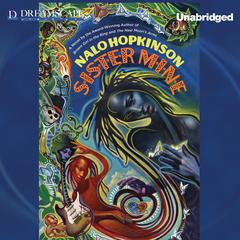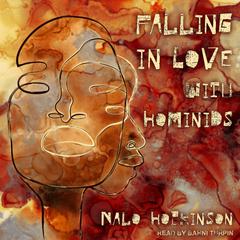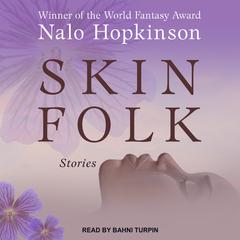 Play Audiobook Sample
Play Audiobook Sample
The New Moon’s Arms Audiobook
 Play Audiobook Sample
Play Audiobook Sample
Quick Stats About this Audiobook
Total Audiobook Chapters:
Longest Chapter Length:
Shortest Chapter Length:
Average Chapter Length:
Audiobooks by this Author:
Publisher Description
What's in a name? A lot, according to Caribbean-born Chastity, who has adopted the more fitting moniker Calamity. Now in her fifties, true to her name, Calamity is confronting two big life transitions: her beloved father has just died, and she is starting menopause, a physical shift that has rekindled her special gift for finding lost things. Suddenly she is getting hot flashes that seem to forge objects out of thin air. Only this time, the lost item that has washed up on the shore is not her old toy truck or her hairbrush, but a four-year-old boy. As Calamity takes the child into her care, she discovers that all is not as it seems: the boy's family is most unusual. Then Calamity must reawaken to the mysteries surrounding her own childhood and the early disappearance of her mother.
Download and start listening now!
"The New Moon's Arms by Nalo Hopkinson is a wonderfully imagined, page-turning offering that combines a bit of fantasy, mystery, and romance. Amid a Caribbean backdrop, the author delivers a story centered on a 53-year-old pistol, Chastity Lambkin, who is grieving the recent loss of her estranged father to lung cancer. She is a sprightly, independent library research assistant who is determined to avoid the matronly image and cling to her youth at all costs. She demands that everyone including her daughter, Ife, and grandson, Stanley, call her Calamity. She holds nothing back (including her tongue) which has caused a long-standing strained relationship with Ife. It is revealed fairly early in the novel that a portion of Calamity's angst resides in unresolved childhood issues and events including an untimely departure of her mother resulting in her father being arrested as a murder suspect in her disappearance when she was ten. Lost love and an unplanned pregnancy at fifteen resulted in her father's emotional, financial, and physical withdrawal from her at sixteen. It is never a dull moment with Calamity. Try as she might, she is losing the battle with Mother Nature and with the encroaching onset of menopause, she reawakens a unique, repressed childhood gift to find lost things. This gift, which hilariously coincides with tingling fingers and hot flashes at the most inopportune moments, results in remnants from the past literally falling from the sky triggering a reemergence of forgotten and sometimes painful memories. Following her father's funeral, Calamity partakes in a drinking binge to wallow in self-pity on the nearby beach. She awakens to discover a "lost" child has washed ashore covered in seaweed. Careful medical examination by her childhood friend-turned- tormentor, Dr. Chow, confirms that the child is a bit "different;'" and deliberately suppresses her suspicions that he is one of the mythical Sea People. When two similar adult bodies are discovered the next day, Calamity identifies with the orphan's apparent parental loss. She names him Agway; embraces and welcomes him into her home worsening her frail relationship with Ife even more. To complicate matters further, she is suddenly overwhelmed by life: Her new love suggests opening the unsolved cold case surrounding her mother's disappearance; Ife's marriage is in shambles spawned by arguments with her husband surrounding the upcoming election and the heated political factions facing the island's tourist trade; Ife's father, her first love, comes to visit and brings his new lover; Stanley needs her assistance to complete his school project; endangered, indigenous seals are missing from the local zoo; and last, caring for a rambunctious three-year-old "merboy" who loves to eat raw shrimp is putting her close to the edge! It may sound a bit convoluted but it is not; the author does an excellent job of lacing the plot threads together and it all comes together beautifully. It is a delightful, endearing story about family, loss, and reclamation. I absolutely loved the infusion of humor, African Diasporatic themes, West Indian culture, language, history, and folklore into the story. This is one of my favorite reads so far this year."
— Mocha (5 out of 5 stars)
Quotes
-
“The New Moon’s Arms is a dance of lost-and-found. Hopkinson knows not to get too sentimental, thanks in large part to her heroine’s unsinkable sense of humor. It let me hear the mermaids singing.”
— Washington Post Book World -
“A most impressive work…vivid and richly nuanced, utterly realistic yet still somehow touched with magic.”
— Toronto Star -
“Hopkinson has had a remarkable impact on popular fiction…[Her] work continues to question the very genre she adopts, transforming them from within through her fierce intelligence and her commitment to a radical vision that refuses easy consumption…With sly humor and great tenderness, [she] draws out the hope residing in age and change.”
— Toronto Globe and Mail -
“Shows new depths of wisdom, humor, and insight…Like life, Hopkinson’s novel doesn’t resolve every mystery. But Hopkinson has answered the essential questions in The New Moon’s Arms, and she’s wise enough to know we need nothing more.”
— Seattle Times -
“Considerable talent for character, voice, and lushly sensual writing…her most convincing and complex character to date.”
— Locus
Awards
-
Finalist for the 2007 Nebula Award for Best Novel
The New Moon’s Arms Listener Reviews
-
" Beautiful book, with a wonderful strong, human, vibrant woman lead character. Takes place on a fictional Caribbean island, and gives you a real feel for the lives of the people who live there. A contemporary setting that blends love,mother/daughter relationships, and other complex emotions with magical realism, "
— Elaine, 2/13/2014 -
" OK, interesting but all over the place. "
— Smithb, 2/9/2014 -
" In her usual unique style, Nalo Hopkinson takes the often-told folk belief that humans and seals are related, and creates a great story. I loved her protagonist Calamity (formerly Chastity) who, instead of experiencing menopause in the usual manner, discovers that she has regained her prepubescent power as a finder of lost things. When she finds a child wrapped in seaweed, she is drawn into a world she briefly experienced as a child. Calamity is far from perfect - she is hostile to gay people because of an early romantic disappointment - but she always tries to do the right thing. Hopkinson's blend of myth, history, West Indian culture and speculative fiction never fails to entertain. A fine read. "
— Wilhelmina, 1/23/2014 -
" This was the first by Hopkinson that I finished. I liked the voice and the setting, disliked the main character (she is deliberately written as rather shrewish, and I'm not convinced she's changed at the end) and was light on the fantasy elements. Having the main character be a woman having magical hot flashes was a nice touch, also her refusal to accept roles as mother or grandmother or elder. Her homophobia was distressing but an important plot point. I'm not rushing to read her other work based on this one. "
— kvon, 1/5/2014 -
" I liked certain aspects of this book, but ultimately I didn't find it convincing. The ending, especially, fell flat. "
— Nicole, 12/30/2013 -
" I've always loved Nalo Hopkinson, not in part because she writes so sensually about a culture I'm completely unfamiliar with. I love learning about other people through fiction; especially through fiction so imbued with folklore and mythic undertones. Yay Nalo! "
— Carri, 12/29/2013 -
" I've read and enjoyed other books by Hopkinson, but this one didn't work for me at all. Definitely a struggle to finish. "
— Rachel, 12/29/2013 -
" This got really hard to read about halfway through. Almost didn't finish it. "
— Sean, 12/28/2013 -
" I loved spending time with the main character--an island woman of a certain age. "
— Marcia, 12/28/2013 -
" I really like magical realism, and this book is an excellent example. A great story well-told. "
— Matthew, 12/4/2013 -
" Go. Read this NOW. You don't need a review, just go find a copy and put it before your eyes. "
— D.J., 7/18/2013 -
" This book is awesome, and the single greatest thing about it is the language that is used. I love it love it love it. "
— Micah, 10/16/2012 -
" That's what I want to write like when I grow up. "
— Catherine, 9/28/2012 -
" This was fun. And the story wasn't completely finished. Real stories never are. I'11 read more of this writer's work. "
— Kitty, 7/27/2012 -
" What I think I liked most about this book was the way the fantastic elements were treated; they were not the focus of the book: Calamity was. This was a wonderful character portrait, and in spite of her flaws, you just have to love Calamity. "
— Clawfoot, 7/4/2012 -
" Really enjoyed this book, eager to read more by Nalo Hopkinson! "
— Cindy, 6/23/2012 -
" I probably didn't need to finish this. It's set in the West Indies with an aging (but still only 50-ish) grandmother as the narrator. She's not likable, & the magical elements of the story, which I guess are intended to spice up an otherwise pretty boring story, are not convincing. "
— Marvin, 4/14/2012 -
" I was not expecting this from her but that doesn't mean I was disappointed. It was like she pulled different elements from a hat that seemed like they wouldn't go together and then made it work. This was a quick and really satisfying read. "
— Melissa, 12/30/2011 -
" Nalo has a wonderful ability to deliver a somewhat well defined character while keeping the story running rather smoothly. I felt sympathy for the protaginist (Calamity) and couldn't help but fight the urge to shake her and scream, 'Wake up and figure out your life!'. "
— Nicholas, 9/26/2011 -
" That's what I want to write like when I grow up. "
— Catherine, 2/19/2011 -
" I was not expecting this from her but that doesn't mean I was disappointed. It was like she pulled different elements from a hat that seemed like they wouldn't go together and then made it work. This was a quick and really satisfying read. "
— Melissa, 3/23/2010 -
" What I think I liked most about this book was the way the fantastic elements were treated; they were not the focus of the book: Calamity was. This was a wonderful character portrait, and in spite of her flaws, you just have to love Calamity. "
— Clawfoot, 7/25/2009 -
" Nalo has a wonderful ability to deliver a somewhat well defined character while keeping the story running rather smoothly. I felt sympathy for the protaginist (Calamity) and couldn't help but fight the urge to shake her and scream, 'Wake up and figure out your life!'. <br/> <br/> "
— Nicholas, 5/8/2009 -
" I loved spending time with the main character--an island woman of a certain age. "
— Marcia, 11/28/2008 -
" OK, interesting but all over the place. "
— Smithb, 11/4/2008 -
" I've always loved Nalo Hopkinson, not in part because she writes so sensually about a culture I'm completely unfamiliar with. I love learning about other people through fiction; especially through fiction so imbued with folklore and mythic undertones. Yay Nalo! "
— Carri, 8/6/2008
About Nalo Hopkinson
Nalo Hopkinson is the author of The New Moon’s Arms, The Salt Roads, Midnight Robber, and Brown Girl in the Ring, among many others. She has won numerous awards, including the John W. Campbell Award, the World Fantasy Award, and Canada’s Sunburst Award for fantasy literature. Her award-winning short fiction collection Skin Folk was selected for the 2002 New York Times Summer Reading List and was one of the New York Times Best Books of the Year. Currently, she is a professor of creative writing at the University of California–Riverside.
About Gin Hammond
Gin Hammond received her MFA from the American Repertory Theatre Institute for Advanced Theatre Training at Harvard University/Moscow Art Theatre School. A native of San Diego, she has worked steadily across the country at theaters such as the Guthrie, Arena Stage, the Longwharf Theatre, ACT, the Pasadena Playhouse, ART, the Berkshire Theatre Festival, and the Studio Theatre. She has also performed internationally at the Moscow Art Theatre and the Roadside Theatre in Heidelberg, Germany. Additionally, Ms. Hammond is a grant recipient of the Ford Mellon Foundation for her work on a multicultural anthology of plays, under the auspices of Ms. Ruby Dee.




























